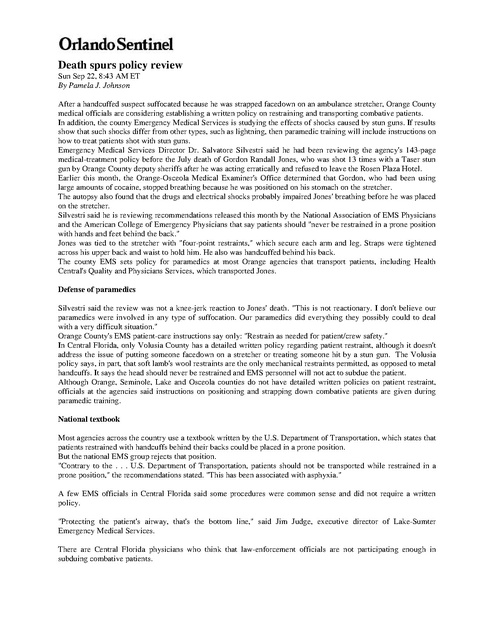Taser Article Death Spurs Policy Review 2002
Download original document:

Document text

Document text
This text is machine-read, and may contain errors. Check the original document to verify accuracy.
OrlandoSentinel Death spurs policy review Sun Sep 22, 8:43 AM ET By Pamela J. Johnson After a handcuffed suspect suffocated because he was strapped facedown on an ambulance stretcher, Orange County medical officials are considering establishing a written policy on restraining and transporting combative patients. In addition, the county Emergency Medical Services is studying the effects of shocks caused by stun guns. If results show that such shocks differ from other types, such as lightning, then paramedic training will include instructions on how to treat patients shot with stun guns. Emergency Medical Services Director Dr. Salvatore Silvestri said he had been reviewing the agency's 143-page medical-treatment policy before the July death of Gordon Randall Jones, who was shot 13 times with a Taser stun gun by Orange County deputy sheriffs after he was acting erratically and refused to leave the Rosen Plaza Hotel. Earlier this month, the Orange-Osceola Medical Examiner's Office determined that Gordon, who had been using large amounts of cocaine, stopped breathing because he was positioned on his stomach on the stretcher. The autopsy also found that the drugs and electrical shocks probably impaired Jones' breathing before he was placed on the stretcher. Silvestri said he is reviewing recommendations released this month by the National Association of EMS Physicians and the American College of Emergency Physicians that say patients should "never be restrained in a prone position with hands and feet behind the back." Jones was tied to the stretcher with "four-point restraints," which secure each arm and leg. Straps were tightened across his upper back and waist to hold him. He also was handcuffed behind his back. The county EMS sets policy for paramedics at most Orange agencies that transport patients, including Health Central's Quality and Physicians Services, which transported Jones. Defense of paramedics Silvestri said the review was not a knee-jerk reaction to Jones' death. "This is not reactionary. I don't believe our paramedics were involved in any type of suffocation. Our paramedics did everything they possibly could to deal with a very difficult situation." Orange County's EMS patient-care instructions say only: "Restrain as needed for patient/crew safety." In Central Florida, only Volusia County has a detailed written policy regarding patient restraint, although it doesn't address the issue of putting someone facedown on a stretcher or treating someone hit by a stun gun. The Volusia policy says, in part, that soft lamb's wool restraints are the only mechanical restraints permitted, as opposed to metal handcuffs. It says the head should never be restrained and EMS personnel will not act to subdue the patient. Although Orange, Seminole, Lake and Osceola counties do not have detailed written policies on patient restraint, officials at the agencies said instructions on positioning and strapping down combative patients are given during paramedic training. National textbook Most agencies across the country use a textbook written by the U.S. Department of Transportation, which states that patients restrained with handcuffs behind their backs could be placed in a prone position. But the national EMS group rejects that position. "Contrary to the . . . U.S. Department of Transportation, patients should not be transported while restrained in a prone position," the recommendations stated. "This has been associated with asphyxia." A few EMS officials in Central Florida said some procedures were common sense and did not require a written policy. "Protecting the patient's airway, that's the bottom line," said Jim Judge, executive director of Lake-Sumter Emergency Medical Services. There are Central Florida physicians who think that law-enforcement officials are not participating enough in subduing combative patients. Medical staff worries At a recent EMS Advisory Council meeting, Dr. Dale Birenbaum of Florida Hospital said that law-enforcement officers at times put staff in danger by leaving patients with nurses and EMS teams. Officials at the Orlando Police Department and the Orange County Sheriff's Office said officers or deputies were not abandoning EMS crews. However, neither agency requires an officer or deputy to ride in the ambulance with a handcuffed patient. "We are not going to stand by and let a combative patient harm anyone," said Orange County Sheriff's Capt. Bernie Presha. "But the question becomes at what point is he a prisoner and at what point is he a patient." Pamela J. Johnson can be reached at pjohnson@orlandosentinel.com or 407-420-5171.





